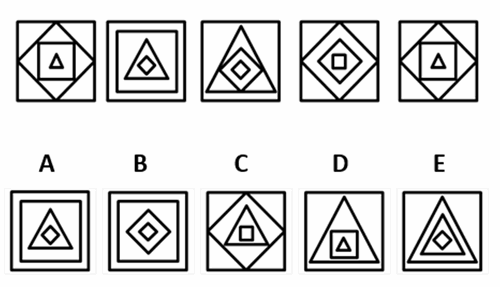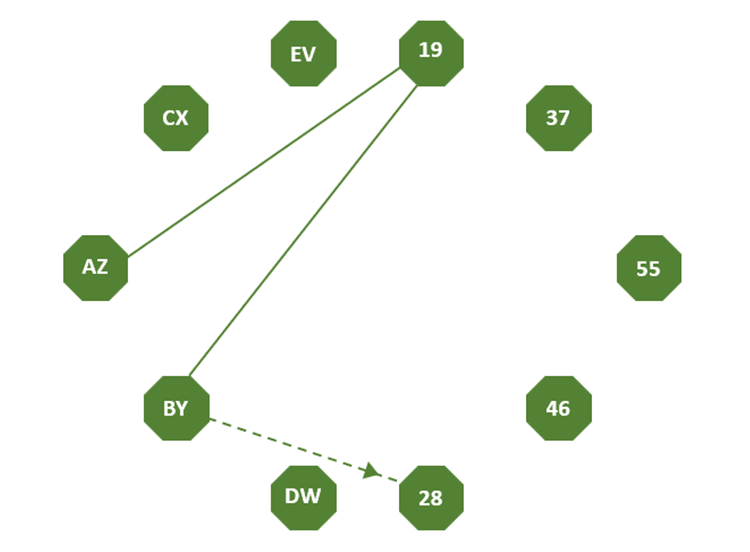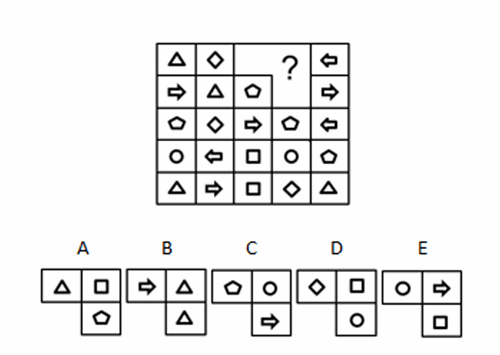Unlock instant entry to authentic SHL Inductive Reasoning practice tests, encompassing the latest interactive format, enhance your critical thinking abilities, and master the examination.
For additional SHL Inductive test questions and more from other fields, visit our free SHL practice test page.
The SHL Inductive Reasoning Test Explained
The SHL inductive reasoning test evaluates your ability to solve puzzles without relying on words or numbers. By presenting you with various shapes and patterns, the test challenges you to discern underlying rules and project what comes next.
One typical question type you'll encounter on SHL's inductive reasoning assessments is as follows:
Choose the image that completes the pattern:

Response: The right choice is option (A).
In the sequence, the shape that's on the inside in one frame moves to become the middle shape in the following frame, the current middle then shifts to the outer position, and the shape that was on the outer edge takes two turns to cycle back to the innermost position. Therefore, in the frame we're trying to fill in, the outer shape needs to be a square (which is the current middle in the fifth frame), the middle should take the form of a triangle (matching the inner shape in the fifth frame), and the diamond (from the outer position in the fourth frame) should appear in the innermost spot.
Did you figure out the right answer? If not, no need to fret—we're about to go through how to approach these kinds of questions.
In the actual SHL Inductive Reasoning test, you'll have just over a minute for each question. That's why it's crucial to practice beforehand.
Comparing Inductive and Deductive Reasoning: Understanding the Distinction
Deductive and Inductive reasoning are both subcategories within logical reasoning.
Candidates applying for certain positions might be required to undertake both inductive and deductive reasoning assessments.
Although they appear to be similar at first glance, each test evaluates a unique set of intellectual skills.
Tests for inductive reasoning generally (but not always) involve an abstract approach. You'll be asked to analyze patterns within visual information and draw general conclusions. Tasks in an inductive reasoning test could involve identifying the next item in a sequence, determining which piece is missing from a given puzzle, or selecting the appropriate figure to complete a matrix.
Conversely, deductive reasoning exercises are typically text-based. Test-takers are presented with a set of premises or propositions, and they need to logically determine the validity of specific conclusions based on those established rules.
Up next:
Let's explore what you'll encounter when taking the SHL Inductive reasoning tests.
The 3 Formats of The SHL Inductive Test
By 2020, the SHL Inductive Reasoning test had evolved into three varied formats, each with its own set of characteristics concerning the time allocated, the nature of questions, and how challenging they are:
- SHL Verify G+ Inductive Reasoning Test (Interactive)
- SHL Verify G+ Inductive Reasoning Test (Non-Interactive)
- CEB Verify Inductive/Logical Reasoning
Below, you'll find a brief explanation of each type along with example questions to help you familiarize yourself with what the test entails.
SHL Verify G+ Inductive Reasoning Test (Interactive)
The SHL Verify G+ Inductive Reasoning Test (Interactive) features 15 questions to be completed within an 18-question timeframe.
Specific instructions will guide you through this hands-on test that requires you to engage directly by dragging and dropping elements on the screen.
This modern SHL assessment transforms the traditional testing experience into an interactive one.
Instead of just picking an answer, you'll be actively manipulating elements within the questions. Expect activities such as pulling lines to continue patterns, tapping to identify the next shape in a sequence, and remembering how specific buttons function.
These tasks are inherently more challenging because they require a deeper level of engagement and strategic thinking, often under tight time constraints of roughly 70 seconds per question.
To give you an idea, let's look at a sample of the kind of question you might encounter on the interactive version.
SHL Interactive Inductive Reasoning Example
Complete the sequence:

Note: on the real test, you’ll be asked to “drag the line to finish the sequence.”
AZ -> 19 -> BY -> 28 -> _____ -> _____ -> _____ -> _____ -> _____ -> _____
In the given problem, we have a series of nodes linked together: AZ connects to 19, and BY, indicated by a dashed line, should connect to 28.
It's evident that each pair of lettered nodes is associated with a pair of numbers, beginning with the AZ node.
AZ – 19: Here, AZ combines A, the first letter of the alphabet, with Z, the final letter. Similarly, the number 1 is the lowest in our sequence, and 9 is the highest.
BY – 28: In this case, B is the second letter in the alphabet, while Y is the penultimate letter. Number 2 is the second lowest, and 8 is the second highest number in our number sequence.
CX – 37: Here, C stands third in the alphabet, and X is the third from the end. Accordingly, 3 is the third lowest number, and 7 is the third highest in the sequence.
The pattern follows this logic throughout the sequence.
Error loading Partial View script (file: ~/Views/MacroPartials/Picture.cshtml)SHL Verify G+ Inductive Reasoning Test (Non-Interactive)
There are 18 questions in total.
The time allotted for completion is 24 minutes.
Specific directions provided: Each question is followed by a set of four or five possible answers. Additionally, the instruction to "Click on the answer…" indicates this test does not allow any form of active interaction.
The SHL Verify G+ Inductive test in its non-interactive form is a traditional multiple-choice exam, contrasting with its interactive counterpart.
This test has similarities to the previous format of the CEB SHL Logical Inductive test, where a majority of the questions focus on series of shapes and completing patterns.
(However, the CEB SHL Inductive test variant contains 24 questions and gives participants 25 minutes to complete them.)
Here's a sample that is reflective of what the actual test may include for both non-interactive versions:
Example of SHL Non-interactive Inductive Reasoning Test:
Select the image that correctly fills in the missing part of the series:

In every horizontal and vertical line, a single figure is repeated once and only once.
Observing the second row from above reveals that one figure, the right-pointing arrow, is already duplicated. To complete this row, we must add a figure not already present, ruling out options A, B, and C which feature figures already in the row.
Examining the topmost row shows no duplicates. Therefore, the solution must involve either a figure that's already in the row (a triangle, a diamond, or a left-pointing arrow), or it must have two new identical figures not in this row. Choice E doesn't meet this criterion, which confirms that the solution is indeed option D.
Mastering the SHL Inductive Reasoning Test
When you first encounter inductive reasoning problems, it can seem daunting.
It's not surprising, really.
These aren't the kind of puzzles we're taught to tackle in school, and some appear completely illogical. Plus, the strict timing adds a layer of challenge that can feel insurmountable.
That's where preparation becomes your secret weapon.
By getting a head start on studying, you'll get familiar with the kinds of questions you'll face (which are just a taste of what's out there). More crucially, you'll learn the strategies needed to crack each type of problem.
The truth is, each inductive reasoning question is built around a specific pattern or logic. When you understand this, everything starts to make a lot more sense.
Presently:
There are a couple of avenues for practice:
- SHL's own inductive reasoning trials and sample items
- The comprehensive SHL Inductive Reasoning practice kit from JobTestPrep
Why Practicing Just Using SHL Direct Might Not Be Enough?
The SHL direct practice platform is often the first preparation tool you'll encounter, typically linked in the email that invites you to take the assessment.
The website offers a handful of example questions (without explanations) and two sets of practice questions for both the interactive and non-interactive versions of the SHL Inductive Reasoning tests.
However, the SHL Direct practice site presents three clear issues:
Firstly, SHL acknowledges that the difficulty of the practice tests does not reflect the true challenge of the actual exam. Consequently, this doesn't allow you to accurately gauge your knowledge or predict your performance on the real test.
Secondly, if you choose to do the interactive practice test, you will not receive any feedback on your performance. On the other hand, with the non-interactive test, you receive a basic score report that simply tallies correct and incorrect responses without specifying which questions you answered incorrectly, leaving you in the dark about which types of questions require more of your focus.
Lastly, this non-interactive score report lacks detailed solutions or explanations. This absence means that it's not possible to learn from your mistakes, forcing you to look for additional resources online to hone your problem-solving abilities.
These pitfalls lead us to consider a second option for practice...
JobTestPrep’s SHL Inductive Reasoning Practice Tests
JobTestPrep offers the most comprehensive preparation for SHL, including the SHL's Inductive Reasoning Test, as of 2025.
The preparation includes:
✔ An extensive selection of practice tests modeled after SHL's inductive reasoning format, encompassing both the interactive and non-interactive versions.
✔ Detailed explanations for each question, guiding you to grasp the underlying principles and preparing you to tackle similar problems in the actual assessment.
✔ Practice conditions that closely mirror the real test environment, including similar difficulty and strict time constraints to acclimate you to the pressure of the timed tests.
✔ Additional practice exercises to further strengthen your skills, aiming not just for a passing score but to position you among the top performers.
Instant Access & Money-back Guarantee
SHL Inductive Reasoning Scores Explained
Each individual who finishes the SHL Inductive test is provided with a downloadable document called the 'Candidate Assessment Report.'
Within this document, you will find your performance details and overall commentary. It's important to understand that your scores are presented in a relative manner, comparing them to a substantial number of other individuals who have also taken the same assessment previously.
The report will determine whether your inductive reasoning capabilities are expected to be a strong point or not when measured against the reference group.
You will be assigned to one of five categories, ranging from A to E, based on your results.

The higher your score is, the closer you’ll be to group A. Unfortunately, the SHL Inductive Reasoning average score is unknown as SHL doesn’t disclose this information.
The cut-off scores, however, differ depending on the hiring company. So, while one company’s cut-off might be in the 80th percentile, other’s might be in the 90th.
Since most companies don’t reveal their cut-off scores, your main goal should be prepping beforehand and scoring as high as possible.
Strategies for Improving Speed on SHL Inductive Reasoning Assessments
The better your score, the more likely you'll approach group A. Regrettably, the average score for the SHL Inductive Reasoning test remains undisclosed, as SHL keeps it confidential.
The threshold scores for passing vary by the employer. Consequently, a passing score could be at the 80th percentile for one organization and at the 90th for another.
Given that most employers keep their threshold scores under wraps, your primary focus should be on thorough preparation to achieve the highest score you can.




